|
|
| Hi Chuck,
Here's a practical and comfortable way to make a 5 gallon bucket toilet.

https://www.duluthtrading.com/items/56982.asp
Standard or with aromatic cedar chips. Made in Canada of course, where heroic, stoic northern woodsmen think of such things all the time.
Bruce Hector
Always searching for a McDonalds where they actually have indoor plumbing, even in Canada.
|
| |
|
Hi,
Don't know if it's approppiate to send this to you but just recieved it from a friend who knows that I am building Nav.....
Here's a guy with only seconds to live...

All the best..
Regards
Robbie Powick
|
| |
|
I have finally added some Real cabin windows, or "Ports" to my "PK-20".
I initially used some storm window plastic and Duck tape just to cover the holes and it has worked remarkably well, and would probably last a few more years.
But, I've been getting a hard time from my fellow "Coots", so I finally broke down and replaced the thin plastic and Duck tape.
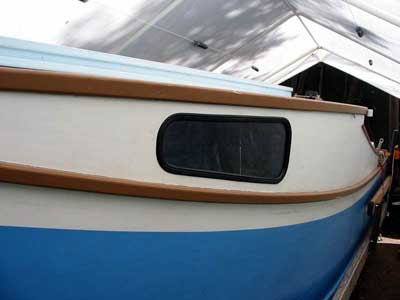
After considering several alternatives I decided to have my long time friends at JB Glass, my local Molalla glass shop install the windows.
I felt I did not need opening window because, with the cabin slot top open I am able to reach anywhere along the boat and with the drop board door forward there is plenty of ventilation.
The windows are Lexan held in with a rubber gasket. Pretty slick. After much searching I finally found a similar gasket material in the JC Whitney catalogue. But I decided to have JB do the work.
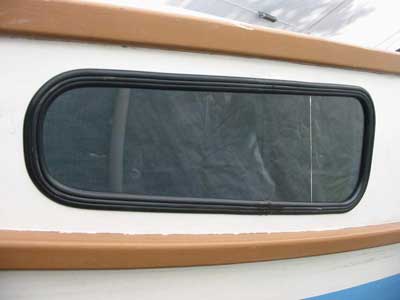
They use the same type of gasket to seal windows on heavy equipment and made quick work of it and did a nice job.
The gasket is rubber and forms a double channel or "H" when installed. The actual gasket extrusion folds open to allow the gasket to wrap around both the Lexan or glass and the 1/4" Cabin sides.
It is then is "Locked" by a press in rubber "Key" that holds the gasket in the "H" shape. The cutout corners for the windows need to be radiuses to no less than 2-1/2" in order for the gasket to bend around the "Glass".
I think they fit well with the "Work Boat" character of my "PK-20".
(And now maybe my buddies will get off my back.)
Pat Patteson
|
| |
|
Dear Sandra,
This picture was taken the day my canoe (Freedom Canoe) was finished. Three
generations of sailors attended the celebration of its "birthing"...
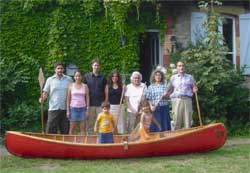
(click for larger view)
I am at the right with a clown face, then my wife (Venezuelian indian
born, theology and philosophy doctor), her mother (venezuelian Indian), my
daughter, her "fiance" (they will be maried next September, he is
gaelic
from UK, yes, a pity !), the wife of my first son, and my son. In the
boat,
are our two grandkids, a girl and a boy. (My second son is not in this
picture, he is a doctor of medicine, working for the Indians in
venezuelian
amazonia...).
I guess the visages we all have, will stay as a comic chapter.
Your Friendl,
Rod
PS.: The paddels we have in hands, are authentics "PEMON" paddles. The
Pemons are Indians from venezuelian amazonas, among the ones we have been
living during ten years between 1980 and 1990, my wife, my sons, and me...
I was a diamond seeker.
Its among them, my second son is now a medic. |
| |
The 4th Annual Lake Charles Yacht Club 'Messabout' will be Saturday, August 6, 2005. Admittance is free. Come spend the day with us.
Location is on the north beach of Lake Charles, Louisiana, at the I-10 Bridge.
Activities begin at 10:00 ish and continue all day. Hot dogs will be served at lunch and an evening meal will be served. All Free! Camping is permitted at the club, but there are no hook-ups.
There are no structured activities, but, we will host a Puddle Duck race sometime during the day. Puddle Duckers are requested to bring a home-made, or otherwise, trophy.
Also, during the day, we will have the 'Battle of Lake Charles'. This will be a water war using squirt-guns, buckets of water, balloons, and etc. (Bring nets to capture used balloons.)
The rest of the time is for messing about in boats of all kinds.
Ken Abrahams
|
| |
| Press Release
26 May 2005
Metmarine launches SMS coastal marine forecasts for The Mediterranean, Northern France, and Atlantic coasts. No sign up required – charged to mobile.
Metmarine SARL has added a new forecast service to its range of services for sea areas from Northern Spain, the Atlantic and Channel coasts of France to the Belgium border. All forecasts are supplied and translated directly from Météo France, and now available on SMS text to a mobile, without pre-registration.
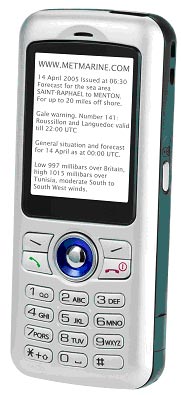 These new services are as per client’s requests for a large area forecast and also ad-hoc forecasts via SMS without prior registration. These are available by typing MET {area code} and SEND to 80160 on UK mobiles, and billed directly to the mobile, or login via the Internet to register any mobile Detailed coastal details are abbreviated for SMS by qualified staff. The wave height service, created uniquely by Metmarine, provides a new level of accuracy and detail via wave buoys and satellite monitoring of Meteo France, also available on SMS. Your Internet password and PIN can also be used on the telephone. These new services are as per client’s requests for a large area forecast and also ad-hoc forecasts via SMS without prior registration. These are available by typing MET {area code} and SEND to 80160 on UK mobiles, and billed directly to the mobile, or login via the Internet to register any mobile Detailed coastal details are abbreviated for SMS by qualified staff. The wave height service, created uniquely by Metmarine, provides a new level of accuracy and detail via wave buoys and satellite monitoring of Meteo France, also available on SMS. Your Internet password and PIN can also be used on the telephone.
Coastal forecasts - www.metmarine.com Freefone in France 0800 9000 51 or 0161 444 8555. This service is accessed via tokens that can be purchased on the Internet or during the call (£1.50/2€) and the overall Mediterranean forecast is free of charge online.
SMS messages are £1.50, maximum fee of £3, as detailed forecasts may be up to 3 or 4 messages in length and additional texts are sent free of charge. Storm warnings, and wave heights messages are selectable from our web site to coincide with the dates of your voyage, allowing automatic receipt of SMS messages, maximum fee £1.50/2€. Prices include VAT. Metmarine is also listed in The Admiralty Book of Signals, on numerous web sites and further links are welcome.
| SMS Area Codes: - |
|
| English Channel |
|
| Cap de La Hague to Penmarc'h |
MET 22 |
| Baie de Somme to Cap de La Hague |
MET 50 |
| Belgium border to Cap de La Hague |
|
| Including Dover and Kent Coast |
MET 80 |
| Atlantic Coast of France |
|
| Anse de L'Aiguillon to Spanish Border |
MET 40 |
| Anse de L'Aiguillon to Penmarc'h |
MET 85 |
| Mediterranean (North) |
|
| Cote D’Azur (Menton to St Raphäel) |
MET 06 |
| Port Camargue to St Raphael |
MET 13 |
| Camargue to the Spanish Border |
MET 34 |
| Corsica |
MET 02 |
| Large Area Forecasts |
|
| Mediterranean |
MET 200 |
| English Channel and Atlantic |
MET 300 |
| North Sea |
MET 400 |
| Wave Heights - Mediterranean |
MET 500 |
| List of codes |
MET 000 |
Example: Cote D’Azur Forecast: Type MET 06 and SEND to 80160
Metmarine Ltd is registered in the UK. SARL Metmarine is registered in France and authorised to translate and distribute forecasts from Meteo France. Peter Herbert, the founder, is a qualified skipper with commercial endorsement and a background with BBC TV, IBM, and founder of The London Stock Exchange global real time data distribution department.
Metmarine SARL
Les Espaces de Sophia
80, route des Lucioles
BP 37 06901 Sophia Antipolis Cedex
Mobile: + 44 7850 363 984 or +33 (0) 6 15 44 78 21
Tel: + 44 (0) 87 0064 0016 Fax: +44 (0) 87 0064 0017 Email: info@metmarine.com |
| |
PRESS RELEASE / Article for Soundings Publications June 1, 2005
Houston, Texas.
FIRE SUPPRESSION WITH PYROGEN,
Pyrogen fire detection and suppression systems have been available to the international market since 2000 and, having taken it by storm, recently expanded into American markets, with activities in recreational pleasure craft, non inspected vessels and military Semi-rigid inflatables . ABYC will consider adding Pyrogen to its next cycle of A-4 FIRE FIGHTING EQUIPMENT.
Pyrogen Aerosol systems, in the Americas are distributed by FirePak oil and Gas industries LLC (FO&GI) headquartered in Houston Texas. An ABYC member FO&GI first established itself in the gaseous systems arena, has since totally switched to the world’s first commercially available aerosol fire suppression system. Compliant with the new NFPA Aerosol Extinguishing Technology NFPA2010, this system, the only genuine Soyuz product in Americas, has helped to make Pyrogen one of the fastest growing flooding agents in this sector.
HOW PYROGEN WORKS
Pyrogen employs a unique extinguishing action. Developed from solid rocket fuel technology, it is an inert, non toxic solid that remains stable until it is electrically or thermally activated, it produces chemical fire suppression products. Pyrogen is not a gas, liquid or a solid, but a new method of producing extremely fine potassium crystals, that act a radical scavengers inhibiting the combination of hydrogen and oxygen in the flame reaction it’s self. Stops fire at the molecular level chemically, and by cooling the fuel.
These micrometer-sized (micron) particles comprised mainly of potassium carbonates and a gaseous mixture of nitrogen and water vapor, blend together to form a fire extinguishing aerosol that is released into the protected area and eliminates any fire within seconds. The aerosol propels itself through a solid chemical coolant, which decomposes as it absorbs any amount of heat, thereby ensuring a safe discharge and uniform distribution of the aerosol. There is no thermal shock to electronics or turbochargers.
It is the high rate of aerosol discharge that ensures success. The agent is rapidly distributed throughout the protected area, and the aerosol particles reach even the most hidden locations. The agent attacks the fire both chemically and physically, and almost instantaneously extinguishes it. Over and above this, long holding times help prevent fire reigniting.
PYROGEN
FO&GI identified a need to include a total flooding clean agent Halon alternative in its product range. After researching and testing approved replacement HFC and PHFC agents, it was determined the post fire damage caused by these systems was unacceptable and FO&GI completely switched over to Pyrogen Aerosol systems. Operated by a double-knock SP-1 fire control system, is designed to protect unoccupied spaces of all shapes and sizes, including pump rooms, machinery spaces, generator sets, computer rooms, control rooms, server rooms, ships’ engine rooms and UPS rooms.
Note: Current US installations are in addition or supplement to USCG minimum requirements and do not replace any existing requirements of ABYC or the USCG. SOLAS IMO/Cir1007 testing to be conducted by the USCG in July 2005. In the interim the commandant as limited the installation to non inspected US vessels.
The marine applications fully approved in Europe by Maritime Coastguard Authority, Bureau Veritas, for vessels up to 24 meters load line length and 4 meters high. Pyrogen has been tested on humans, so its safety is guaranteed. It emits a gaseous fog (like CO2) when discharged and has an added feature of a directional valve system that allows multiple hazards to be protected against at minimal cost.
THE BENEFITS OF PYROGEN
The advantages of using Pyrogen are many and varied. To begin with, the applications are at least three times more effective than Halon products. This is because, at a design concentration of 100 g/m3, Pyrogen exhibits equal or better extinguishing properties than Halon 1301 at 330 g/m3 (5% by volume), as certified by Scientific Services Laboratory (Australia) AFP1317. The product has the lowest extinguishing concentration among commercially available agents, and has been designed as a safe and practical alternative to Halon, halocarbons, chemical powders, CO2 and inert gases.
Another advantage Pyrogen offers is its ability to be installed internally in the compartments that are to be protected. Units can actually be fitted in the engine compartments of vehicles and machinery spaces.
To elaborate, activation methods vary according to the nature of the site of the areas to be protected. Activation can be electrical, from a conventional fire panel, or thermal, from a thermal cord that is attached to the aerosol generator, initiated by a preset temperature being reached. If these two methods should fail due to extraneous reasons, self-activation will occur. The post-activation residue has a 24 kV insulation property, which enables the immediate reuse of electrical equipment following the replacement of the components that created the fire and the replacement Pyrogen unit.
Pyrogen units are self-contained, with zero pressure. Because they contain no pressurized cylinders or pipe work they are extremely light and safe to transport, and they cannot leak, burst or deteriorate. Also with space requirements up to one fortieth of inert gases, and weight penalties of often only 10% of competing systems, Pyrogen is in many cases the only practical Halon replacement.
Yet another advantage of Pyrogen applications is their low toxicity gradient. They do not give off aggressive acids, such as hydrogen fluoride upon contact with hot surfaces, nor is chlorine or bromide produced at any stage of its application. Additionally, the units do not deplete oxygen to suppress the fire. Recent US NAVY toxicology test establish a fifteen (15) minute safe exposure level for humans. They chemically inhibit combustion, and can be used as emergency shut down on diesel engines and generator sets without damage to the power plant.
Pyrogen is environmentally friendly. It has been certified as having zero ozone depleting potential and zero global warming potential, and has officially listed by the US Environmental Protection Authority under its Halon replacement significant new alternatives program since 1996.
Added to all this is the fact that Pyrogen canisters are simple to install and commission. Their easy plug-in wiring and connectors can reduce installation times by up to a third or less. New canisters can be installed within minutes, and this eliminates the potentially dangerous periods of non-active fire suppression, or pulling into a yard for refit or repairs. Pyrogen certifies and Accredits installers and design engineers insure proper installation and operation of the systems.
Last, but by no means least, Pyrogen is cost effective.
Videos and CDs are also available to make it even easier to understand the advantages of Pyrogen products and services.
HOW TO PURCHASE PYROGEN
A call to the FirePak offices from a potential client is referred to the local distributor to installer. This is followed by a visit to vessel to yard, where an inventory of equipment to be protected is made. The information is used to prepare a customer’s proposal/quotation. A number of trained and qualified installation engineering teams are available for complete installation and commissioning, or initial tuition to enable clients to undertake their own installations.
For more information please visit the website, http//www.pyrogen.com/home.htm
About the author
John Brooks is a retired Naval Officer and member of the AUVSI ABYC, MBS, NFPA, IAFC, SAE and serves on numerous fire protection standards and aerospace safety committees.
|
| |
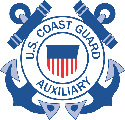 Date: June 12, 2005 Date: June 12, 2005
Contact: Aux. Wayne Spivak
Division Chief - External Communications
Public Affairs Department
United States Coast Guard Auxiliary
https://www.auxpa.org
516-353-9155
Media@auxpa.org
False Distress Hoax ties up CG and Local Law Enforcement
Wantagh, NY - A distress call this afternoon claiming that a body was in the water near Wantagh Park, sent multiple agencies on what became a wild goose chase.
The caller, a male with an accent, using marine VHF channel 16, the marine distress frequency, calmly reported a body face down in the water being kept afloat by a PFD.
The radio caller then proceeded to switch channels to the Coast Guard working frequency, and provided Longitude and Latitude, as well as a phone number to the Coast Guard.
Responding to the scene were Coast Guard and Auxiliary boats, a Coast Guard Auxiliary mobile radio facility, Coast Guard Watch standers (radio operators), Nassau County Police Marine units as well as the Town of Hempstead, NY Bay Constable.
After a twenty minute search of the area, the failure to reach the radio caller, and the determination that the phone number was phony, the Coast Guard determined the call to be a hoax.
False distress calls cost the American public large amounts of money, as well as put others at risk, as Coast Guard and other responders are not available for real emergencies.
Knowingly and willfully transmitting a hoax distress call is a felony. It is punishable by up to six years in prison, a $250,000 fine and restitution to the Coast Guard for all costs incurred responding to the distress. The maximum civil penalty is $5,000.
The Coast Guard is serious about stopping false distress calls. On 14 April a federal judge in Detroit ordered a North Carolina man to pay $10,000 in restitution for making a false distress call to the US Coast Guard.
The man was sentenced to 2 years probation and 4 months house confinement after pleading guilty in January to making a false distress call.
The United States Coast Guard Auxiliary is composed of uniformed, non-military volunteer's who assist the Coast Guard in all of its varied missions, except for military and direct law enforcement. These men and women can be found on the nation's waterways, in the air, in classrooms and on the dock, performing Maritime Domain Awareness patrols, safety patrols, vessel safety checks and public education.
The United States Coast Guard Auxiliary was founded in 1939 by an Act of Congress as the U.S. Coast Guard Reserve and re-designated as the Auxiliary in 1941. Its 30,000 members donate millions of hours annually in support of Coast Guard missions.
####
|
| |
|
|

